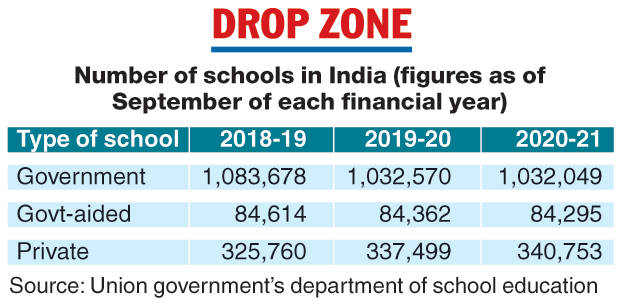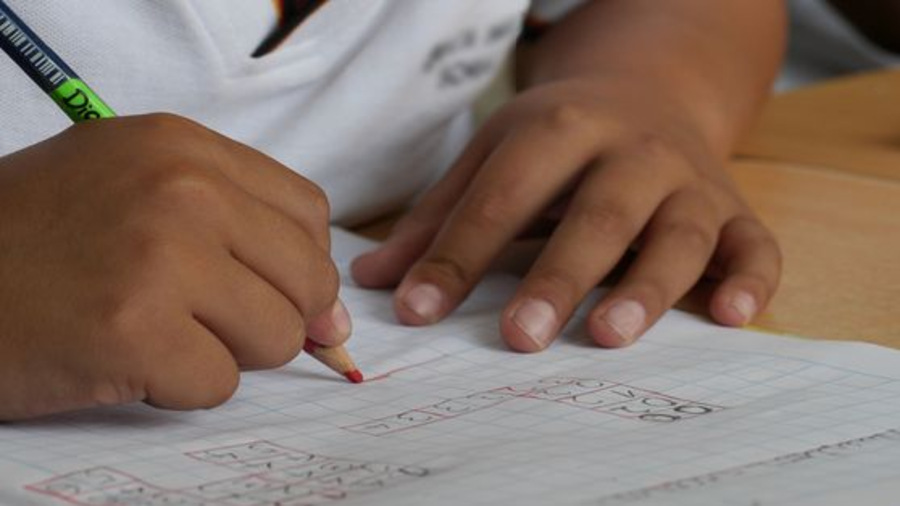The number of government schools in the country fell by 51,000, or 4.78 per cent, in the year between September 2018 and September 2019, official data show.
During the same period, the number of private schools jumped by 11,739 or 3.6 per cent.
Education activists said this reflected a trend towards privatisation of education at the grassroots level, too. They said the government was only too glad to see the poor quality of its schools prompting parents to shift their children to private schools, which gave it an excuse to close the low-enrolment schools by “merging” them with nearby schools.
According to the school education department’s United District Information System for Education (UDISE) Plus reports, the number of government schools fell from 1,083,678 in 2018-19 to 1,032,570 in 2019-20, marking a drop of 51,108. The figures are counted till September of each year. (See chart)

The UDISE Plus report for 2020-21, released last week, shows a further dip by 521 to 1,032,049, the relatively smaller decline presumably owing to a slowdown in school mergers amid the pandemic.
While the figures for 2019-20 and 2020-21 are part of the respective years’ final UDISE Plus reports, the 2018-19 count is from the provisional UDISE Plus report. It was invoked by then education minister Ramesh Pokhriyal in response to a question in the Lok Sabha on September 14, 2020.
The final report for 2018-19 has not been released, but education activists said it would not have made much of a difference.
They added that most of the closures involved primary schools.
In 2016, a group of government secretaries had recommended the “consolidation” (merger) of schools with low enrolment, with the Niti Aayog supporting the proposal the following year on the ground of “rationalisation”.
During meetings with the states, the then human resource development ministry had encouraged them to merge these schools with the nearest schools. The Centre provides a sizeable portion of the funds for state government schools.
Under the Right to Education Act, every class needs to have a teacher. If a primary school has less than 50 children across all five classes, it becomes too costly for the government to support such a school with five regular teachers, it was argued.
Certain states pursued the policy aggressively. Uttar Pradesh witnessed a decline in the number of government schools by 26,074 — from 163,142 in September 2018 to 137,068 in September 2020 — and Madhya Pradesh that of 22,904, from 122,056 to 99,152.
Odisha set itself a target of closing down 14,000 schools but, because of legal hassles, was eventually able to shut 5,227 government schools, its count falling from 55,483 to 50,256 between September 2018 and September 2020.
Many states, though, witnessed small increases in the numbers of government schools. In Bengal, the number rose from 82,876 to 83,379, while Bihar saw an increase from 72,590 to 75,555.
The UDISE Plus reports did not explain the reasons for the decline in the number of government schools.
Education activists said the central and state governments’ failure to appoint regular teachers and their engagement of teachers in surveys and election duty affected the quality of teaching and learning, forcing parents to look towards private schools.
“Even the teachers mostly send their children to private schools. Most government schools encourage rote learning, anyway, and don’t bother about the learning outcome,” Ashok Agrawal, president of the All India Parents-Teachers Association and a member of the Delhi University court, said.
He said the situation would worsen in the next two decades and that the government schooling system — which offers free education and is expected to be a lifeline for the poor — was headed for abolition.
Sameet Panda, a Right to Food Campaign activist who also works towards ensuring RTE Act compliance in Odisha, said the Centre’s school-closure policy had led to many tribal children being denied education.
“In tribal areas, the schools are sparsely located. Many schools have been closed, forcing the children to sit at home because the nearest school is 5km away. This is denial of the right to education and the right to dignified life,” Panda said.
Mitra Ranjan, an activist associated with the RTE Forum, an NGO, said the government was abdicating its responsibility by arguing that low-enrolment schools should be closed.
“The government should do a mapping exercise for the dropouts and the children engaged as child labourers. They must be brought back to school. Then all the government schools will be crowded,” Ranjan said.
In a written reply in the Rajya Sabha to a question on the closure and merger of government schools, education minister Dharmendra Pradhan had in March said that opening or closing schools was the province of state governments since education was “in the concurrent list”.










